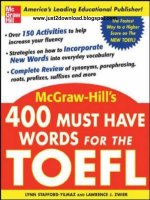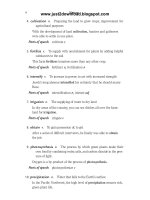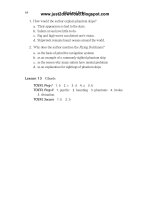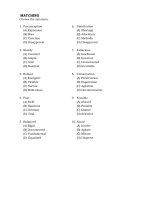The MBA Center Grammar Review for the TOEFL - part 9 docx
Bạn đang xem bản rút gọn của tài liệu. Xem và tải ngay bản đầy đủ của tài liệu tại đây (16.45 KB, 5 trang )
For more material and information, please visit Tai Lieu Du Hoc at
www.tailieuduhoc.org
afraid of
amazed at, by
angry with, about
annoyed with, about
anxious about
ashamed of
associated with
aware of
based on
blessed with
bored of, with
capable of
careful of, with
certain of, about
characterized by
cluttered with
committed to
composed of
concerned with, about
connected to
content with
convinced of
coordinated with
crowded with
curious about
dedicated to
devoted to
different from
disappointed with, in
divorced from
eager for
engaged to, in
envious of
equipped with
excited about
expert at
exposed to
faithful to
familiar with
famous for
filled with
fond of
free from, of
friendly with
full of
furnished with
glad about
good at
41
For more material and information, please visit Tai Lieu Du Hoc at
www.tailieuduhoc.org
grateful to, for
guilty of
innocent of
interested in
involved in
jealous of
known for
late for
limited to
made of, from
married to
necessary for
nervous about
obliged to
opposed to
patient with
pleased with, about
polite to
prepared for
proud of
ready for
remembered for
responsible to, for
sad about
safe from
satisfied with
scared of
separate from
slow at
sorry about, for
surprised about, at
terrified of
tired of
typical of
upset with
used to
valued for
worried about
wrong about
VII. Conjunctions
Conjunctions are words that connect two parts of a sentence that depend logically on each
other. They make the relationship between two clauses more clear. Many of the
prepositions we just looked at are, in fact, conjunctions. (For example, but can be a
conjunction.)
42
For more material and information, please visit Tai Lieu Du Hoc at
www.tailieuduhoc.org
The testing point for most conjunctions is the idiomatic form. Therefore, we will
concentrate on the idiomatic form of each conjunction.
Neither/Either
These two conjunctions describe a situation where two subjects agree on a negative
action. There are two forms. Be careful not to use a double negative: either a positive verb
with the negative “neither” or a negative verb with the positive “either.”
Statement + neither + Verb + Subject.
Statement + Subject + Negative Verb + either.
I don’t like coffee, and neither does she. (not “neither doesn’t she”)
I don’t like coffee, and she doesn’t either. (not “she doesn’t neither”)
Be careful. They can also be used in positive sentences and even as the subject of a
sentence
Neither of the two proposals is satisfactory.
or
Neither is satisfactory.
Either of the two proposals is satisfactory.
or
Either is satisfactory.
They can be used as a positive or negative response to a question.
Would you like tea or coffee?
Neither, thank you.
Either is fine, thank you.
(Remember that “either” and “neither,” by themselves, are always singular.)
And of course, there are the idiomatic forms.
Either + or
Neither + nor
Either the teacher or the students should know where to go.
Neither the teacher nor the students know where to go.
Advanced rule
There is a unique structure for these typical idioms. Note that you will always use two
nouns in this conjunction, and the number of the verb will always depend on the second
example! Be careful.
43
For more material and information, please visit Tai Lieu Du Hoc at
www.tailieuduhoc.org
Neither the ticket nor the credit cards are here.
Neither the credit cards nor the ticket is here.
Either the plane or the three buses are fine with me.
Either the three buses or the plane is fine with me.
So/So that/So too
“So” and “So that” are both conjunctions of result. Both describe a result of the other
clause in the sentence.
The library was closed so I went home and studied there.
I enrolled in a TOEFL class so I would perform better on the test.
The movie was so good that I saw it again.
He moved to the front row so that he could see more clearly.
“So Too” is used to describe a repeated action. There are two forms.
Statement + So + Verb + Subject.
Statement + Subject + Verb + Too.
She will take the exam, and so will I.
She will take the exam, and I will too.
I wanted to find the record, and so did she.
I wanted to find the record, and she did too.
“So too” can also be used in the emphatic form to describe a similar characteristic.
Whereas Joyce was a great Irish writer, so too did Bequeath contribute to the
country’s canon.
Despite/In spite of
These idioms are the most common idioms on the test. TOEFL questions which test these
idioms are what our teachers call “free questions” because you do not need to read the
sentence to choose the right answer. It is always a matter of form, and there are only two.
In spite of or Despite
These forms mean almost exactly the same thing: an action that occurs when another
action is against it.
44
For more material and information, please visit Tai Lieu Du Hoc at
www.tailieuduhoc.org
In spite of the poor weather, the wedding was beautiful.
He went to Las Vegas anyway despite my good advice.
Both and/Both and as well as
These conjunctions connect two or more words performing, describing, or modifying the
same thing. Make sure to use parallel structure.
Both Lewis and Chris are enjoying Paris.
Both Lewis and Chris, as well as David, are enjoying Paris.
The lecture was both entertaining and informative.
The lecture was both entertaining and informative, as well as required.
Lucy and Dan, as well as Julian, are going to the beach.
Lucy, Dan, and Julian are going to the beach.
As/As if
“As” can sometimes mean “because.”
As it was raining, we didn’t take our afternoon walk
But it can also be used when two actions occur at the same time.
Emily fell as she was trying to climb a tree.
And it can be used to describe a duration of time.
As the class went on, I felt more and more tired.
“As if” is used to describe how somebody or thing sounds, feels, or looks.
It looks as if we are not going to finish on time.
Mario sounded as if he wasn’t confident about the plane.
She felt as if she had never worked a day in her life.
By/By the time/Until
These conjunctions are used to describe a time when something should be ending.
I should be finished with this work by Thursday.
By the time I got there, the line was already around the block.
She said she wouldn’t know anything until the official report.
Not but/Not only but also“Not but” is used to show a preference of one thing over
another. It must keep the idiomatic form.
I liked not the colors but the lines of the painting.
(not I liked not the colors but also the lines )
45









